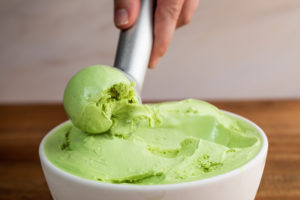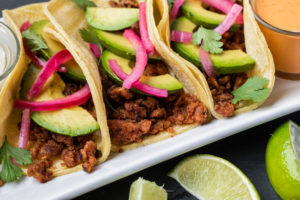With so many different types of natural colors, choosing the right one for your confection application can feel overwhelming. Whether you’re creating a boiled sweet, gummy, panned candy, marshmallow, or chocolate, there are some important factors to consider when choosing a natural color. We’ve broken down the top 5 considerations when coloring confections to make your color selection process easier.
1. Processing Conditions
The first thing you’ll need to consider is your product’s processing conditions. Will high heat be involved in the process? When will the color be added? If your product undergoes a high heat treatment, it’s important to choose a heat stable natural color. High temperatures during processing can cause certain colors, like spirulina and red beet, to fade. For example, hard candies and lollies are boiled to high temperatures for a long period of time, so make sure to use colors that have high heat stability, such as anthocyanins, beta-carotene, annatto, turmeric, and copper chlorophyll[in].
If you need to use colors with lower heat stability, like spirulina or beet, another solution is to add the color later in the process. For gummies and boiled sweets, adding the color during the cooling or forming stage helps reduce the chance of color degradation, as can be seen with the Spirulina in the hard candies below. In general, the later the color is added to the formulation the better, as it reduces heat exposure to the color. And be sure to keep in mind that thermal conditions can vary from the lab to production scale.
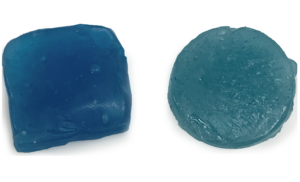
2. Product Type
Natural colors will behave differently based on the type of confection you’re working with. In a foam product or pulled hard candy, air is incorporated during the process which will reduce the impact of the color making it appear lighter and less intense. In this case, you’ll need to overdose the color (or add more color than you need up front) to compensate for this.
If you’re working with a panned candy, the color vibrancy of the final product will appear different depending on the base color. If you pan the color directly onto a chocolate base, the final color will appear muted or dull, like in the image below. Panning on a white base layer, though, will allow for the color to appear more vibrant since the base color isn’t adding any dark undertones.
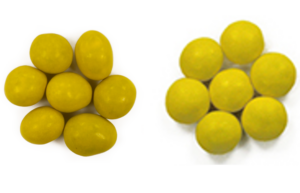
When making boiled sweets, the final clarity could be impacted by both the natural color you choose, and the other ingredients present in the mix. Sometimes you might want the boiled sweet to be clear, whereas others may need to have more of an opaque look. If clarity is an important factor to the final look, then choosing the correct natural color is an important consideration.
3. Regional Limitations
Every country has their own regulatory requirements, so it’s important to know where you’ll be selling your confection product as this can impact natural color selection. There may be different requirements depending on the region. For example, safflower is a great bright yellow option for confections in the EU, but it is not permitted as a color in the US. You’ll have to opt for a color like turmeric instead.
Even if a natural color is permitted for use in a certain region, there may still be limitations surrounding how it is used. Chlorophylls are widely used in the EU and Latin America for multiple applications, including confections, but are not permitted in the US outside of dry mix beverages. Other natural colors, such as annatto and carmine, have maximum use limits by specific application types.
4. Product Formulation
The product formulation for your confection will also be important to consider when choosing a color since certain ingredients, like gelling agents, can impact natural colors in different ways. For example, different gelling agents for gummies will result in different base colors and clarity. In the case of copper chlorophyllin, a gelatin-based gummy will appear a dull, cloudy lime shade while a carrageenan-based gummy will be a clear, blue-green shade.
The pH of the system can also affect color. Anthocyanins, like Amaize® red, purple carrot, and elderberry, are pH sensitive colors. This means the hue will shift depending on the pH of the application. If you’re working with a confection at a low pH, such as a gummy or boiled sweet, anthocyanins will appear red. But if you try to use them at a higher pH, like in a marshmallow, the color will turn purple or start to fade.
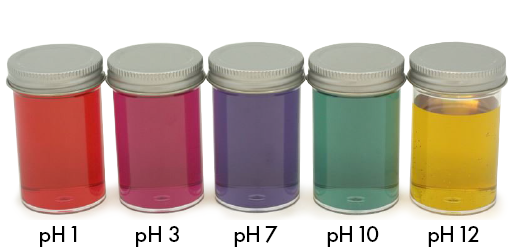
5. Storage and Packaging
How will your confection be packaged and stored? Packaging and storage conditions will differ based on the kind of confection you’re working with. If your packaging is transparent, it’s best to use more light stable colors, such as carotenes, paprika, luteins, carbon black or anthocyanins. In the case of beta-carotene, the inclusion of ascorbic acid will help to improve its storage conditions.
Lastly, the label claims and positioning of the final product are an important part of color selection. These on-pack claims could require Kosher, Halal, Certified Organic, or non-GM colors and are often region specific. Early planning with these considerations will lead to the correct selection of appropriate colors earlier on in the development process.
Figuring out how to choose the right natural color for your confection application can be difficult, but when you choose the right one, your eye-catching confection will win out above the rest! Need some help deciding? Contact us with your questions.



